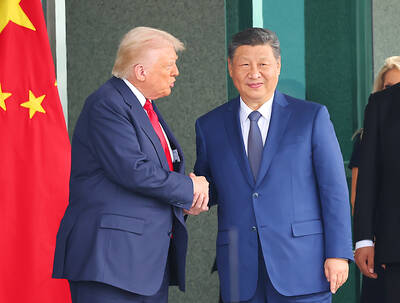Annual revenue from computer games exceeded US$100 billion globally for the first time last year, with China overtaking the US as the “gamer capital of the world” in terms of market size, a report published by London-based venture capital firm Atomico said.
The 600 million gamers in China generated US$24.6 billion of the industry’s US$101.1 billion global market value last year, just ahead of the US’ US$24.1 billion.
In 2015, the global games industry was worth US$91.8 billion, data from research house Newzoo showed.
A notable contributor to the growth has been Apple’s mobile app store in China.
Last year, China accounted for 31 percent of the total US$18 billion generated by games on iOS, compared with just 3 percent of the US$2.4 billion total in 2012.
Tom Wehmeier, principal and head of research at Atomico and author of the report published on Thursday, said a number of other major milestones were passed last year.
“We’ve got to the point today where there are now more than 2 billion gamers globally, and mobile has really taken over to the extent that it’s the largest segment overall,” Wehmeier said.
Mattias Ljungman, a partner at Atomico and one of its cofounders alongside Niklas Zennstrom, said that “the average revenue per user is higher in China than the US, which to me would probably make most people fall off their chairs.”
China’s importance to the growth of the global gaming industry is not difficult to see.
Tencent Holdings Ltd (騰訊), China’s largest Internet company by market value and one of the 10 largest public tech companies in the world, has seen enormous success from its mobile gaming and advertising divisions, including social networking platform WeChat (微信) and desktop game League of Legends.
It also owns Honour of Kings, which analysts have estimated would contribute more than 50 percent of Tencent’s smartphone game revenue this year and recorded monthly gross revenue of as much as 3 billion yuan (US$440 million) last month.
In Europe and the US, numbers are still rising alongside investor confidence, Atomico said.
The global games industry is expected to generate US$109 billion in revenue this year, of which 42 percent would come from mobile titles, Atomico said.
That could rise to as much as US$129 billion by 2020, at which point mobile would overtake the combined value of all traditional platforms for games — console and PC — by generating 51 percent of the total revenue for the industry, it said.
“Games have become truly mass market and it’s a massive, massive opportunity that’s only going to get bigger,” Ilkka Paananen, CEO of Supercell, the developer of the popular Clash of Clans mobile game, said in the report.
“One of these days somebody’s going to build a game that reaches a billion users a month,” he said.
Much of China’s gaming market is contained at home, with little international appeal.
Atomico’s report, citing research house App Annie, said that as much as 93 percent of all money spent by Chinese gamers go to titles developed by Chinese-based companies.
This compares with 56 percent of US gamers spending on US-developed games and 36 percent of Europeans spending on games developed in the EU.
Breaking into the Chinese market would require a pairing of international development talent with local Chinese expertise, said Teemu Huuhtanen, chief executive officer of Next Games Oy and previously vice president of mergers and acquisitions at Rovio.
“You probably need a local partner and localize the game more than just the language,” Huuhtanen said in the report. “You’re better off working with a Chinese partner and really taking the time to localize the game for their specific market.”
Ljungman said that such models are going to continue to evolve.
“I think things like joint ventures are going to be something that can become a lot more interesting and allow people to be engaged, but still keep focus on their Western businesses,” he said.
A model like a joint venture “gets you quicker into the market and allows you to integrate better, develop things more quickly and still retain a lot of value,” he said. “I think it’s something worth considering.”
Many Chinese industrial companies, from chemical solvent producers to poultry processors, have been buying up Western games companies as a way of boosting their overall profit margins, thanks to the high margins so many of these entertainment businesses command.

RUN IT BACK: A succesful first project working with hyperscalers to design chips encouraged MediaTek to start a second project, aiming to hit stride in 2028 MediaTek Inc (聯發科), the world’s biggest smartphone chip supplier, yesterday said it is engaging a second hyperscaler to help design artificial intelligence (AI) accelerators used in data centers following a similar project expected to generate revenue streams soon. The first AI accelerator project is to bring in US$1 billion revenue next year and several billion US dollars more in 2027, MediaTek chief executive officer Rick Tsai (蔡力行) told a virtual investor conference yesterday. The second AI accelerator project is expected to contribute to revenue beginning in 2028, Tsai said. MediaTek yesterday raised its revenue forecast for the global AI accelerator used

TEMPORARY TRUCE: China has made concessions to ease rare earth trade controls, among others, while Washington holds fire on a 100% tariff on all Chinese goods China is effectively suspending implementation of additional export controls on rare earth metals and terminating investigations targeting US companies in the semiconductor supply chain, the White House announced. The White House on Saturday issued a fact sheet outlining some details of the trade pact agreed to earlier in the week by US President Donald Trump and Chinese President Xi Jinping (習近平) that aimed to ease tensions between the world’s two largest economies. Under the deal, China is to issue general licenses valid for exports of rare earths, gallium, germanium, antimony and graphite “for the benefit of US end users and their suppliers

Dutch chipmaker Nexperia BV’s China unit yesterday said that it had established sufficient inventories of finished goods and works-in-progress, and that its supply chain remained secure and stable after its parent halted wafer supplies. The Dutch company suspended supplies of wafers to its Chinese assembly plant a week ago, calling it “a direct consequence of the local management’s recent failure to comply with the agreed contractual payment terms,” Reuters reported on Friday last week. Its China unit called Nexperia’s suspension “unilateral” and “extremely irresponsible,” adding that the Dutch parent’s claim about contractual payment was “misleading and highly deceptive,” according to a statement

Artificial intelligence (AI) giant Nvidia Corp’s most advanced chips would be reserved for US companies and kept out of China and other countries, US President Donald Trump said. During an interview that aired on Sunday on CBS’ 60 Minutes program and in comments to reporters aboard Air Force One, Trump said only US customers should have access to the top-end Blackwell chips offered by Nvidia, the world’s most valuable company by market capitalization. “The most advanced, we will not let anybody have them other than the United States,” he told CBS, echoing remarks made earlier to reporters as he returned to Washington